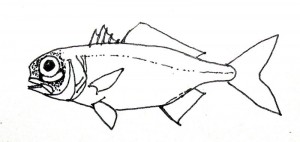Bioluminescence occurs when a biological organism produces a chemical reaction where energy is released in the form of light. A familiar example of bioluminescence is the firefly, emitting a yellow-green light. In the marine environment, most bioluminescence appears as a neon, blue glow. Some small organisms in the sea, such as plankton, produce their own chemicals used to create light, commonly seen as glowing waves crashing onto the shore during moonless nights. Most bioluminescent animals; however, rely on a symbiotic relationship with bacteria to produce the chemical reaction for their host. Marine fishes also depend on bacteria and have developed special organs to house the bacteria called photophores. Bioluminescence in fish serves several functions; prey attraction and capture, predator deterrence and confusion, mate attraction, communication between members of the same species, and navigation and signaling when schooling.
On a moonless night in Matuku, I saw an example of two of these functions; prey attraction and schooling. I turned my dive light off to check the reef for bioluminescent creatures and soon witnessed the bioluminescence of two groups of 20-30 spots of blue suddenly merge into one large group and dart through the reef in distinct, synchronized movement. When I turned my light on, the flash of a typical silverside body was all I could see as the fish dispersed and disappeared into the small crevices of the reef. Shortly after turning my light off again, tiny lines of photophores would appear in a scattered clusters and merge again into a distinctly structured formation of schooling fish.
When the school left I noticed a small glowing ball off in the distance. Swimming slowly through the dark toward the neon glow, I saw a pair of alien-like eyes take shape; the creature appeared to be a swimming back and forth. I watched for a while, sure it was a fish and quickly flashed my dive light in that direction. It was a flashlight fish – an extraordinary find and unique example of bioluminescence.
Flashlight Fish Use Bioluminescence to Attract Zooplankton and Confuse Predators
View a video of flashlight fish here: http://www.youtube.com/watch?v=p3_mLJZPD4A
Flashlight fish are a rarely spotted; they are nocturnal, spending daylight hours tucked into deep-water caves and crevices. Their preferred habitat is the seaward side of the forereef near steep drop-offs where caves are plentiful. During daylight hours they typically inhabit depths between 180 – 400 meters (500 – 1320 feet). Under the cover of darkness they migrate to shallow waters in search of prey but return to the safety of their deeper cave before dawn. On dark moonless nights, such as this one, flashlight fish are known to venture to waters as shallow as 2 meters (6 feet). I was at 10 meters depth.

Flashlight fish are one of the few bioluminescent species that are not considered a true deep-sea fish. There are three species of flashlight fish, each from a different genus, in the family Anomalopidae (order Beryciformes). This individual was Photoblepharon palpebratus. The glowing ‘eyes’ that I saw were actually large, oval-shaped photophores located just beneath each eye, a characteristic trait of the Beryciformes. It is the largest photophore with the brightest glow of almost any bioluminescent species. The light that a flashlight fish emits can be seen from over 100 feet (30 m) away! Zooplankton, animal plankton, are drawn to the glowing ‘eyes’ of a flashlight fish. Not only will the flashlight fish eat the zooplankton, it will also wait and consume all the small fish that come near to feed on the illuminated zooplankton.
Their symbiotic bacteria are constantly producing the light emitting chemical reaction but flashlight fish are able to rotate the photophore downward, covering the light. They use this mechanism to evade predators but shutting the light off or confusing a pursuing predator by blinking the light while swimming in a zig-zag pattern to confuse the predator. I believe I was witnessing prey attraction and schooling due to the lack of the predator avoidance behavior – ‘blinking.’
Next time you’re on a night dive, turn off your lights and see what sees you.
Graphic: Courtesy of Wikemedia Commons
Video by: Dawn Bailey
To follow along and see more photos, please visit us on Facebook!